Operating system concepts
(Seventh edition) 2008.3
solutions to the exercises
Chapter 1
1.1 In a multiprogramming and time-sharing environment, several users share the
system simultaneously. This situation can result in various security problems.
a. What are two such problems?
b. Can we ensure the same degree of security
machine? Explain your answer.
in a time-shared machine as in a dedicated
Answer:
a. Stealing or copying one’s programs or data; using system resources (CPU, memory,
disk space, peripherals) without proper accounting.
b. Probably not, since any protection scheme devised by humans can inevitably be
broken by a human, and the more complex the scheme, the more difficult
confident of its correct implementation.
is to feel
it
1.2 The issue of resource utilization
of operating systems. List what resources must be managed
carefully in the
Workstations connected to servers c. Handheld computers
following settings: a. Mainframe
shows up in different
forms in different
types
or minicomputer systems b.
Answer:
a. Mainframes:memory and CPU resources, storage, network bandwidth.
b. Workstations: memory and CPU resouces
c. Handheld computers: power consumption, memory resources.
1.3 Under what circumstances would a
rather than a PC or single-user workstation?
user be better off
using a timesharing system
the task is large, and the hardware is fast,
sense. The full power of the system can be brought
Answer: When there are few other users,
time-sharingmakes
user ’s problem. The problemcan be solved faster
case occurs when lots of other users need resources at the same time.
A personal computer is best when the job is small enough to be executed reasonably
on it and when performance is sufficient to execute the
satisfaction.
to bear on the
than on a personal computer. Another
program to the user ’s
1.4 Which of the functionalities
system for the following
a. Batch programming b. Virtual memory c. Time sharing
two settings:
listed
below need to be supported by the operating
(a) handheld devices and (b) real-time
systems.
Answer: For real-time
systems,
the operating system needs to support virtual memory
�
Operating system concepts
(Seventh edition) 2008.3
and time sharing
to provide
programming is not necessary in both settings.
virtual
system needs
Batch
in a fair manner. For handheld systems,the operating
memory, but does not need to provide
time-sharing.
1.5 Describe
are three advantages and one disadvantage of multiprocessor systems?
the differences
between symmetric and asymmetric multiprocessing.What
Answer: Symmetric multiprocessing treats all processors as equals, and I/O can be
processed on any CPU. Asymmetric multiprocessing
CPUs are slaves. The master distributes
done by the master only.
Multiprocessors can save money by not duplicating power supplies,housings, and
peripherals.
reliability.
uniprocessor systems.
They can execute programs more quickly
They are also more complex
tasks among the
slaves, and I/O
and can have
in both hardware and software
has one master CPU and the remainder
increased
than
is usually
1.6 How do clustered systems differ from multiprocessor systems? What is required
for two machines belonging to a cluster to
service?
cooperate to
provide a highly available
computers
task distributed
constructed by combining multiple
across the cluster.
systems on the other hand could be a single physical entity comprising
than a multiprocessor
Answer: Clustered systems are typically
into a single system to perform a computational
Multiprocessor
of multiple CPUs. A clustered
system.Clustered
multiprocessor system could communicate using shared memory.
In order for twomachines to provide a highly available service, the state on the
two machines should be replicated and should be consistently updated. When one of
the machines fail, the other could then take-over the functionality of the failed
machine.
systems communicate using messages, while
system is less
processors
coupled
tightly
in a
1.7 Distinguish between the client-server and peer-to-peer models of distributed
systems.
Answer: The client-server model firmly distinguishes the roles of the client and
server. Under this model, the client requests services that are provided by the
server. The peer-to- peer model doesn’t have such strict
in the system are considered peers and thus may act as either clients or servers
- or both. A node may request a service from another peer, or the node may in fact
provide such a service to other peers in the system.
For example, let ’s consider a system of nodes that share cooking recipes.Under
client-server model, all recipes are stored with the server. If a
access a recipe, it must request the recipe from the specified server. Using the
peer-to-peer model, a peer node could ask other peer nodes for the specified
In fact,
roles.
client wishes to
recipe.
all nodes
the
�
Operating system concepts
(Seventh edition) 2008.3
The node (or perhaps nodes) with the requested recipe could provide it to the
requesting node. Notice how each peer may act as both a client
recipes) and as a server (it may provide recipes.)
(i.e.
it may request
1.8 Consider a computing cluster
two ways in which the cluster software can manage access to the data on the disk.
Discuss the benefits and disadvantages of each.
consisting
of twonodes running adatabase.Describe
one host runs the database application with
the monitoring host becomes
and parallel
the following
two alternatives:
asymmetric clustering
Answer: Consider
clustering. With asymmetric clustering,
the other host simply monitoring
If
the active server. This is appropriate for providing redundancy. However, it does
the potential
not utilize
the database application
implementing
mechanism for files on the shared disk.
can
clusters
processing power of both hosts. With parallel
on both hosts.
is providing
in parallel
the server
parallel
fails,
run
it.
clustering,
The difficulty
some form of distributed
locking
1.9 How are network computers different
Describe some usage scenarios
in which it
from
traditional
computers?
is advantageous to use network computers.
personal
have a minimal operating
Answer: A network computer relies on a centralized
It can therefore
computer on the other hand has to be capable of providing all of the required
functionality
Scenarios where administrative costs are high and where sharing leads to more
efficient
preferred.
in a standalonemanner without
use of resources are precisely
system to manage its
relying
those settings where network computers are
computer for most of its services.
resources. A personal
on a centralized
manner.
1.10 What is the purpose of interrupts? What are the differences
an interrupt? Can traps be generated intentionally by a user program? If so, for
what purpose?
between a trap and
returned
Answer: An interrupt is a hardware-generated change-of-flow within the system. An
interrupt handler is summoned to deal with the cause of the interrupt; control is
then
software-generated
an I/O to obviate
system routines or to catch arithmetic errors.
instruction.
can be used to signal
the need for device polling.
An interrupt
interrupted
interrupt.
context
and
the
to
A
trap
a
the completion of
is
A trap can be used to call operating
1.11 Direct memory access is used for high-speed I/O devices in order to avoid
increasing the CPU ′s execution load.
a. How does the CPU interface with the device to coordinate the transfer?
b. How does the CPU know when the memory operations are complete?
c. The CPU is allowed
to execute other programs while
the DMA controller
is
�
Operating system concepts
(Seventh edition) 2008.3
transferring data. Does this process interfere with the execution of the user
programs? If so, describe what forms of interference are caused.
can be
independently
accessed by
values
the device.The
into special
device
a DMA operation by writing
Answer: The CPU can initiate
that
corresponding operation once it receives a command from the CPU. When the device
is finished with its operation, it interrupts the CPU to indicate the completion
of the operation.
Both the device and the CPU can be accessing memory simultaneously.The memory
controller
A CPU might therefore be unable to issue memory operations at peak speeds since it
has to compete with the device in order to obtain access to the memory bus.
provides access to the memory bus in a fair manner to these two entities.
registers
initiates
the
1.12 Some computer systems do not provide a privileged mode of operation
Is it possible to construct a secure operating system for these computer systems?
Give arguments both that it is and that it is not possible.
in hardware.
type would need to remain in control
Answer: An operating system for a machine of this
(or monitor mode) at all times. This could be accomplished by two methods:
a. Software interpretation of all user programs (like some BASIC,Java, and LISP
systems, for example). The software interpreter would provide, in software, what
the hardware does not provide.
b. Require meant that all programs be written in high-level languages so that all
object code is compiler-produced. The compiler would generate (either in-line or
by function calls) the protection checks that the hardware is missing.
1.13 Give two reasons why caches are useful.What problems do they solve? What
problems do they cause? If a cache can be made as large as the device for which it
is caching (for instance, a cache as large as a disk), why not make it that large
and eliminate the device?
a buffer of intermediate
speed between the components. If
Answer: Caches are useful when two or more components need to exchange data, and
the components perform transfers at differing speeds.Caches solve the transfer
problem by providing
fast device finds the data it needs in the cache, it need not wait for the slower
device. The data in the cache must be kept consistent with the data in the components.
If a omponent has a data value change, and the datum is also in the cache,
the cache
must also be updated. This is especially a problem on multiprocessor systemswhere
more than one process may be accessing a datum.Acomponent may be eliminated by an
equal-sized cache, but only if: (a) the cache and the component have equivalent
state-saving capacity (that is,if the component retains its data when electricity
is removed, the cache must retain data as well), and (b) the cache is affordable,
because faster storage tends to be more expensive.
the
�
Operating system concepts
(Seventh edition) 2008.3
1.14 Discuss, with examples, how the problem of maintaining
manifests itself in the following processing environments:
a. Single-processor systems
b. Multiprocessor systems
c. Distributed systems
coherence of cached data
the memory needs to be updated when a processor
processors might be caching
the
systems,
Answer: In single-processor
issues updates to cached values. These updates can be performed immediately or in
a lazy manner. In amultiprocessor
same memory location in its local caches. When updates are made, the other cached
locations need to be invalidated or updated. In distributed systems, consistency
of cached memory values
when a client caches file data.
system,different
is not an issue. However, consistency problems might arise
1.15 Describe a mechanism for enforcing memory protection in order to prevent a
program from modifying the memory associated with other programs.
Answer: The processor could keep track of what locations are associated with each
process and limit access to locations that are outside of a program
Information
base and limits registers and by performing a check for every memory access.
regarding
the extent of a program’s memory could be maintained by using
’s extent.
1.16 What network configuration would best suit the following environments?
a. A dormitory floor
b. A university campus
c. A state
d. A nation
Answer:
a. A dormitory floor - A LAN.
b. A university campus - A LAN, possible a WAN for very large campuses.
c. A state - AWAN.
d. A nation - A WAN.
1.17 Define the essential properties of the following types of operating systems:
a. Batch
b. Interactive
c. Time sharing
d. Real time
e. Network
f. Parallel
g. Distributed
h. Clustered
i. Handheld
�
Operating system concepts
(Seventh edition) 2008.3
the computer
times through buffering,
off-line
transactions where the results
card from the terminal,
This system is composed of many short
to keep CPU and I/O devices busy at all
Answer:
needs are batched together and run through
a. Batch. Jobs with similar
as a group by an operator or automatic job sequencer. Performance is increased by
attempting
operation, spooling, andmultiprogramming. Batch is good for executing large jobs
that need little interaction; it can be submitted and picked up later.
b. Interactive.
of the next transaction may be unpredictable. Response time needs to be short
(seconds) since the user submits and waits for the result.
c. Time sharing. This systems uses CPU scheduling and multiprogramming to provide
economical interactive use of a system. The CPU switches rapidly from one user to
another.
its next control
to the screen.
d. Real time. Often used in a dedicated application,
from sensors and must respond within a fixed amount of time to ensure correct
performance.
e. Network. Provides operating
f. SMP. Used in systems where there are multiple CPU
of the operating system.Communication takes place across the system bus.
g. Distributed.This
processors. The processors do not share memory or a clock.
has
communication lines, such as a high-speed bus or local area network.
h. Clustered. A clustered system combines multiple computers into a single system
to perform computational task distributed across the cluster.
i. Handheld. A small computer system that performs simple
from
email,
systemswith smallermemory and display screens and slower processors.
own local memory. They communicate with each other
and web browsing. Handheld systems differ
system distributes
computation
its
among several
physical
Instead, each processor
various
through
tasks such as calendars,
traditional
desktop
Instead of having a job defined by spooled card images, each program reads
and output
is normally printed
immediately
this system reads information
system features across a network such as file
sharing.
’s eac h running the same copy
1.18 What are the tradeoffs inherent in handheld computers?
in smaller memory, smaller screens, and slower processing capabilities
Answer: Handheld computers are much smaller than traditional desktop PC
results
a standard desktop PC. Because of these limitations,most handhelds currently can
perform only basic tasks such as calendars, email, and simple word processing.
However, due to their small size,
with wireless access, can provide remote access to electronic mail and the world
wide web.
they are quite portable and, when they are equipped
’s. This
than
�
Operating system concepts
(Seventh edition) 2008.3
Chapter 2
2.1 The services and functions
two main categories. Briefly
provided by an operating system can be
divided into
the two categories and discuss how they differ.
describe
is
system
concurrently
between different
provided
processes
to access only thosememory locations
by an operating
running
to enforce
the system.
that are associated with
Answer: One class of services
protection
Processes are allowed
their address spaces. Also, processes are not allowed to corrupt files associated
with other users. A process is also not allowed
operating system ntervention.
The second class of services provided by an operating system is to provide new
functionality that is not supported directly by the underlying hardware. Virtual
memory and file systems are two such examples of new services provided by an operating
system.
to access devices directly without
in
2.2 List five services provided by an operating system that are designed to make
it more convenient for users to use the computer system. In what cases it would be
impossible for user-level programs to provide these services? Explain.
tapes, serial
it,
that
request
into
device-
the system converts
of a file
trusted to
programs cannot be trusted
(or sections)
not be
or
to only access
lines, and other devices must be communicated
while
commands. User-level
Answer:
? Program execution. The operating system loads the contents
into memory and begins its execution. A user-level program could
properly allocate CPU time.
? I/O operations. Disks,
with at a very low level. The user need only specify the device and the operation
on
to perform
controller-specific
devices they should have access to and to only access them when they are otherwise
unused.
? File -system manipulation. There are many details in file creation, deletion,
allocation, and
not have to perform. Blocks of
are used by files and must be tracked. Deleting a file requires removing the name
file
to assure proper file access. User programs could neither ensure adherence to
protection methods nor be trusted
on file deletion.
? Communications. Message passing between systems requires messages be turned
packets of
communications medium, and reassembled by the destination system. Packet ordering
and data correction must take place. Again, user programs might not coordinate access
for other processes.
to the network device, or they might receive packets destined
? Error detection.
levels.
At the hardware level,
occurs at both the hardware and software
only free blocks and deallocate blocks
blocks. Protections must also be checked
all data transfers must be inspected
the network controller,transmitted
naming that users should
to ensure that data have
and freeing
the allocated
Error detection
information,
sent
to
into
across a
information
to allocate
disk space
�
Operating system concepts
(Seventh edition) 2008.3
not been corrupted in transit. All data on media must be checked to be sure they
have not changed since
must be checked for data consistency; for instance, do the number
to the media. At the software
they were written
level, media
and
of allocated
process-independent
unallocated blocks of storage match the total number on the device. There, errors
are frequently
so there must be a global program (the operating system) that handles all types of
errors. Also, by having errors processed by the operating system, processes need
not contain code to catch and correct all the errors possible on a system.
the corruption
instance,
(for
of data on a disk),
2.3 Describe
three general methods for passing parameters
to the operating
system.
Answer:
a. Pass parameters in registers
b. Registers pass starting addresses of blocks of parameters
c. Parameters can be placed, or pushed, onto the stack by the program, and popped
off the stack by the operating system.
2.4 Describe how you could obtain a statistical
by a program executing different sections of its code.Discuss the importance of
obtaining such a statistical profile.
profile
of the amount of time spent
timer
interrupts
Answer: One could issue periodic
what sections of code are currently executing when the interrupts are delivered.
A statistical
the time spent by the program in different sections of its code. Once such a
statistical
of code that are consuming more of the CPU resources.
the programmer could optimize
has been obtained,
profile
profile
of which pieces of code were active should be consistent with
and monitor what instructions
or
those sections
2.5 What are the five major activities of an operating system in regard to file
management?
on and deletion of files
Answer:
? The creati
? The creation and deletion of directories
? The support of primitives for manipulating files and directories
? The mapping of files onto secondary storage
? The backup of files on stable (nonvolatile) storage media
2.6 What are the advantages and disadvantages of using the same systemcall
for manipulating both files and devices?
interface
Answer: Each device can be accessed as though it was a file
most of the kernel deals with devices
through
this
file
in the file system. Since
interface,it
is relatively
�

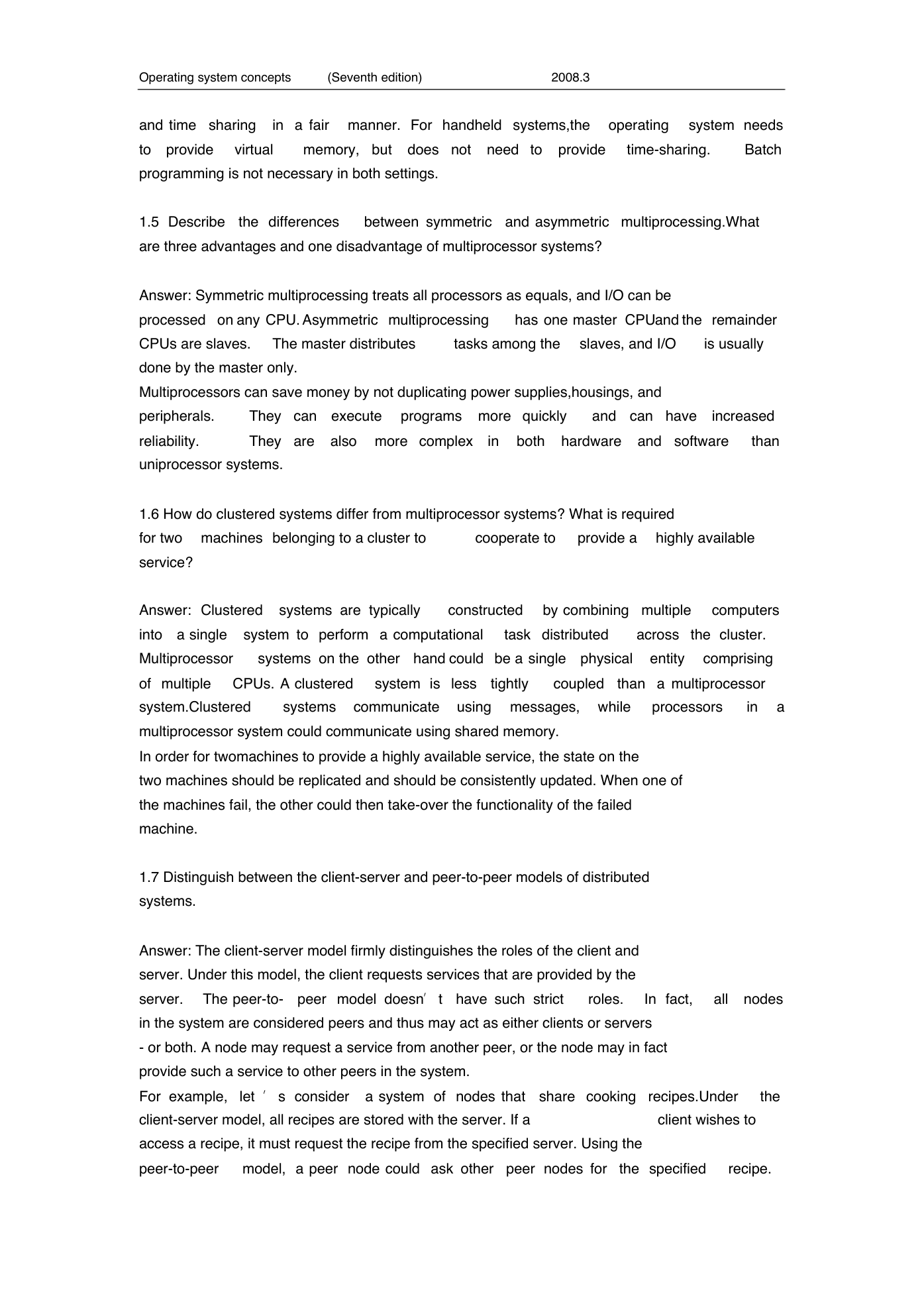
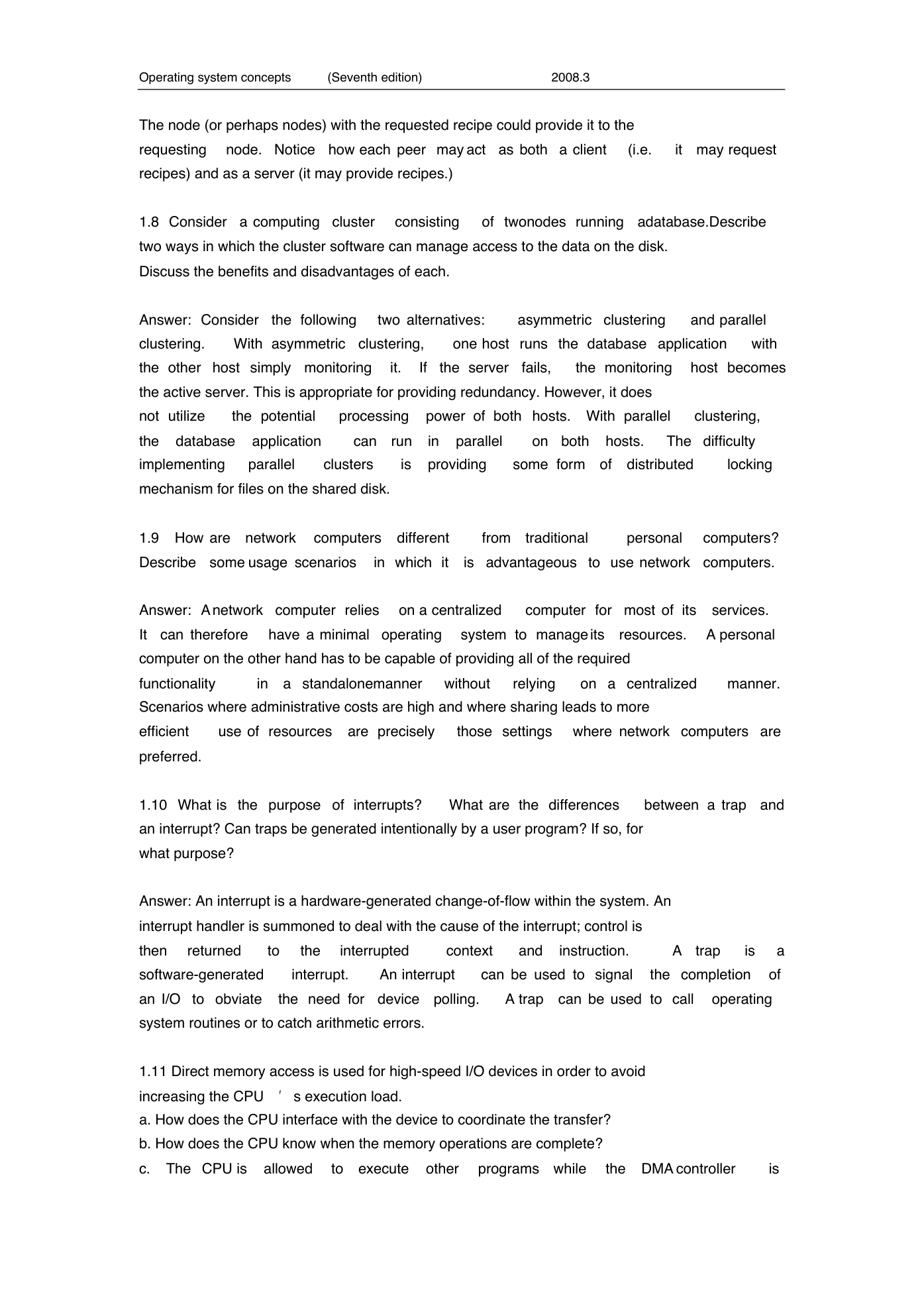
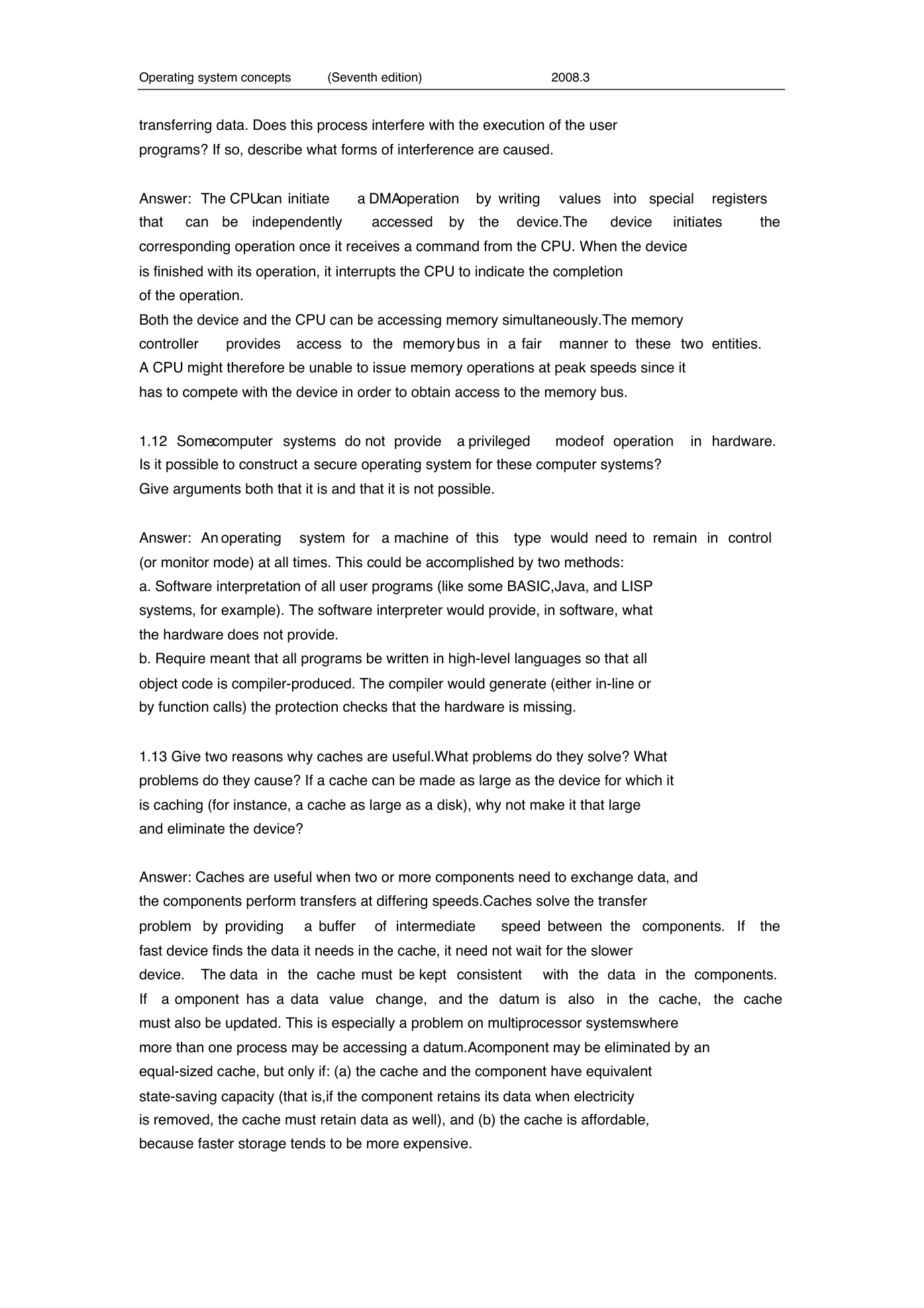
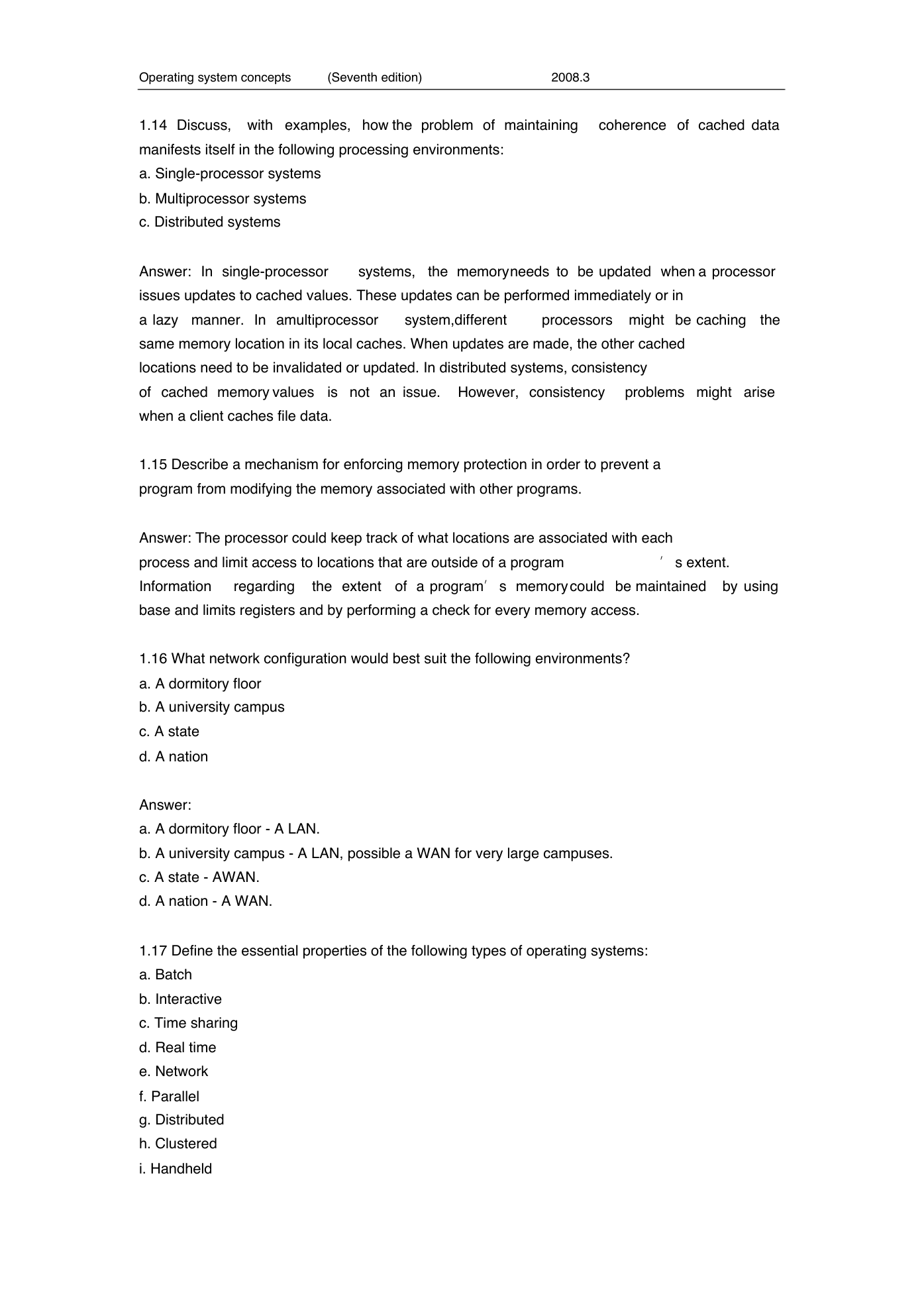

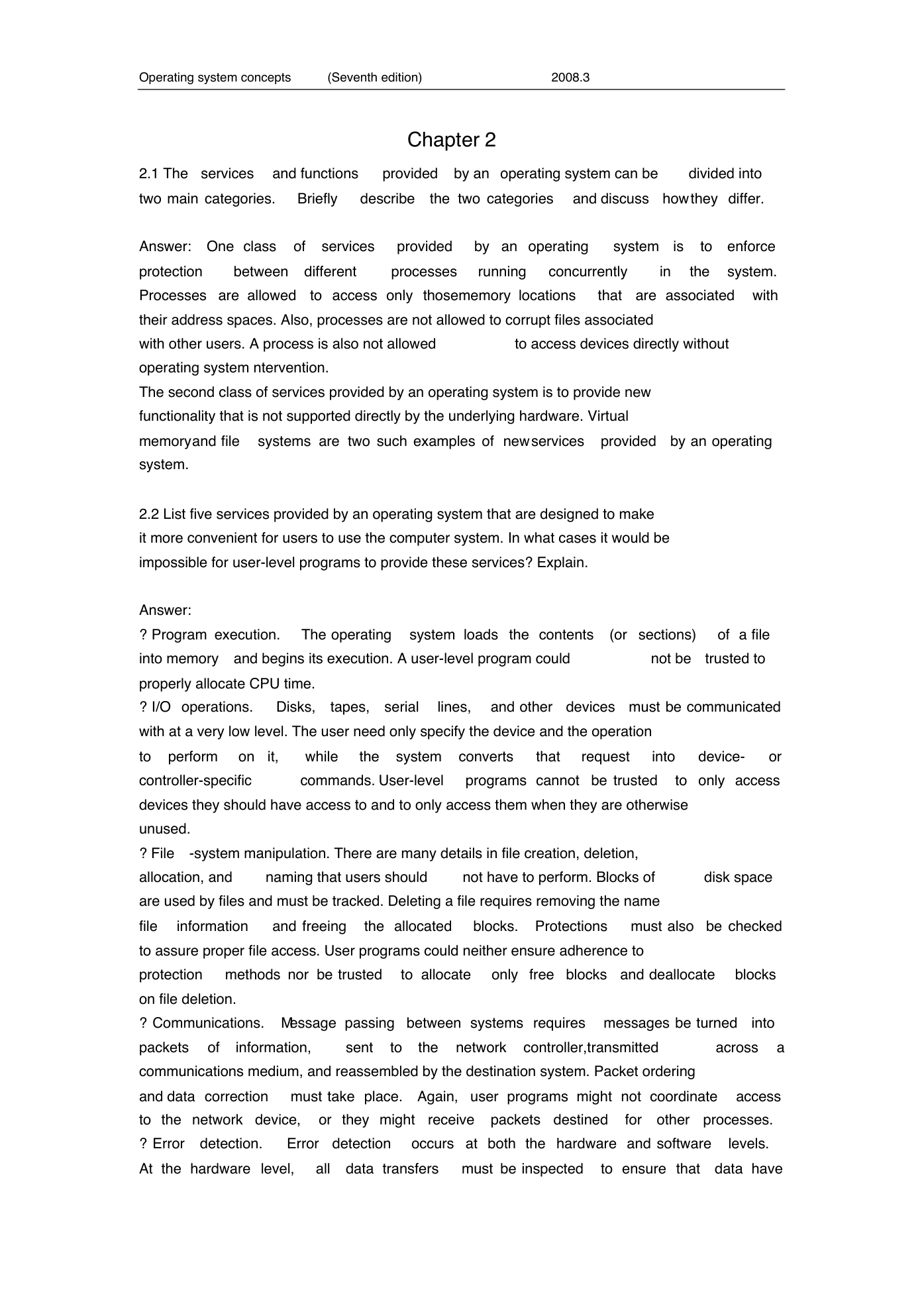
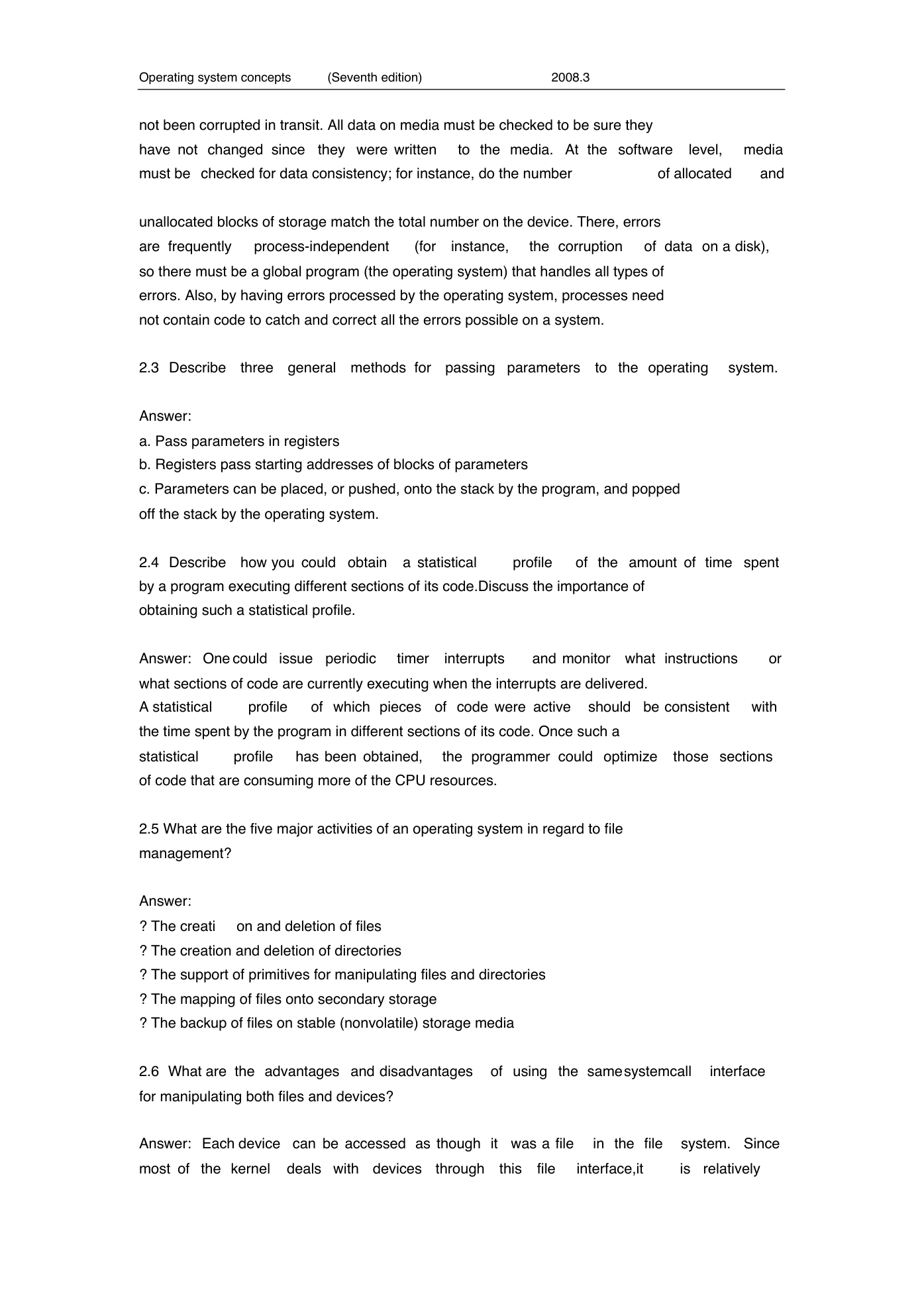








 2023年江西萍乡中考道德与法治真题及答案.doc
2023年江西萍乡中考道德与法治真题及答案.doc 2012年重庆南川中考生物真题及答案.doc
2012年重庆南川中考生物真题及答案.doc 2013年江西师范大学地理学综合及文艺理论基础考研真题.doc
2013年江西师范大学地理学综合及文艺理论基础考研真题.doc 2020年四川甘孜小升初语文真题及答案I卷.doc
2020年四川甘孜小升初语文真题及答案I卷.doc 2020年注册岩土工程师专业基础考试真题及答案.doc
2020年注册岩土工程师专业基础考试真题及答案.doc 2023-2024学年福建省厦门市九年级上学期数学月考试题及答案.doc
2023-2024学年福建省厦门市九年级上学期数学月考试题及答案.doc 2021-2022学年辽宁省沈阳市大东区九年级上学期语文期末试题及答案.doc
2021-2022学年辽宁省沈阳市大东区九年级上学期语文期末试题及答案.doc 2022-2023学年北京东城区初三第一学期物理期末试卷及答案.doc
2022-2023学年北京东城区初三第一学期物理期末试卷及答案.doc 2018上半年江西教师资格初中地理学科知识与教学能力真题及答案.doc
2018上半年江西教师资格初中地理学科知识与教学能力真题及答案.doc 2012年河北国家公务员申论考试真题及答案-省级.doc
2012年河北国家公务员申论考试真题及答案-省级.doc 2020-2021学年江苏省扬州市江都区邵樊片九年级上学期数学第一次质量检测试题及答案.doc
2020-2021学年江苏省扬州市江都区邵樊片九年级上学期数学第一次质量检测试题及答案.doc 2022下半年黑龙江教师资格证中学综合素质真题及答案.doc
2022下半年黑龙江教师资格证中学综合素质真题及答案.doc